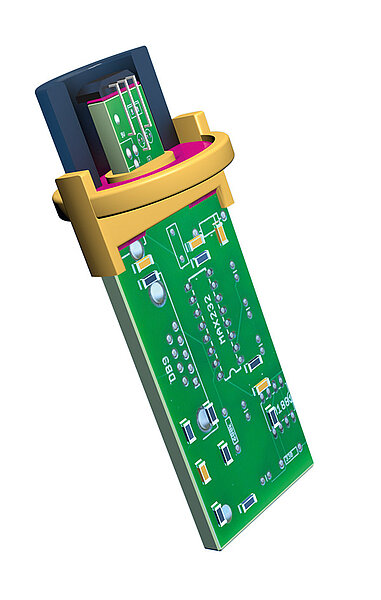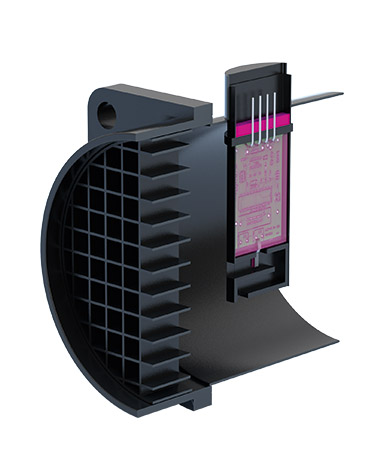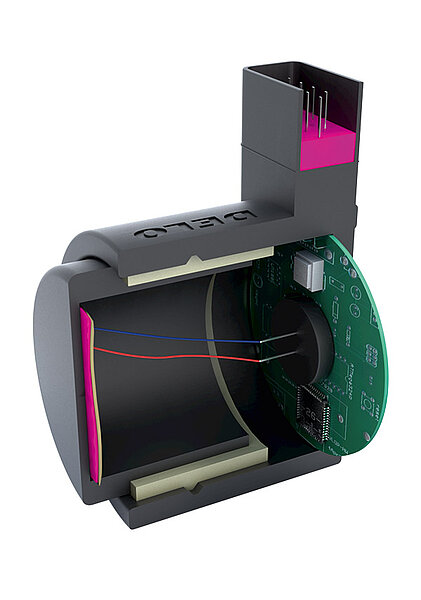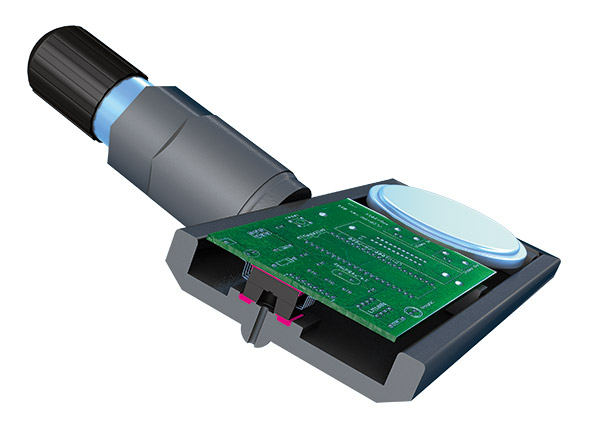Just the Right Mix
Mass air-flow and TMAP sensors help reduce emissions and are located in the engine compartment, or more precisely in the air intake system. The mass air-flow sensor, MAF for short, has the primary task of communicating the incoming air mass to the engine control unit. This quantity is needed in both gas and diesel engines to calculate various parameters. Mass air-flow sensors are somewhat more precise than TMAP sensors. A TMAP sensor measures the pressure and the intake temperature and can use this data to determine air mass.
In order to protect sensors, extremely reliable epoxy resins of the DELO MONOPOX and DELO-DUOPOX portfolio are used that pass all the typical automotive tests. They are resistant to oil, gas, and braking fluid and can survive in a temperature range of - 40 °C to +155 °C. Even when stored at these temperatures, the encapsulant on the sensor does not display any stress cracks. There is also no interaction between the transmission oil and encapsulant.
Finding the Right Balance
Hall sensors are always applicable when position or speed need to be captured. These sensors are sometimes located directly on the wheel rim, or even on the wheel hub. From there, they provide accurate information on how frequently the wheel is rotating. For their assembly, dual-curing (light- / anaerobic-curing) adhesives are especially appropriate because they enable a rapid prefixation of the magnet, the magnet retainer and the Hall sensor. In addition, they secure final curing, even in shadowed areas. The adhesives are also highly resistant to media impacts like oil, gas, or even braking fluid, and also pass salt spray tests, reflow tests (JEDEC), vibration tests, and drop tests with flying colors.
Under Pressure
Sensors are also used as alarm triggers as soon as the tire pressure drops. They are therefore very important with respect to safety, fuel efficiency, and wear. The incorrect tire pressure can create a huge risk of having an accident by significantly extending the braking distance or negatively impacting stability when cornering.
For die attach, sealing and fixing tasks, heat-curing DELO MONOPOX epoxy resins are preferably used, while 2C materials of the DELO-DUOPOX series are used for large-volume PCB casting. They all have in common that they are especially media-resistant and repellant against typical automotive fluids. In particular, they can withstand salt spray and cleaners. They also provide impressive results in thermal shock, humidity storage, vibration and drop tests. In order to ensure that pressure measurement always works correctly, the tightness of the sensor fixation to the housing is checked with a typical pressure of 7 bar for the long term and 9.5 bar for the short term.
Safe Parking Made Easy
When it comes to parking distance sensors, it is essential that the driver be able to depend on the accuracy of the data. This is because sensors help the driver safely maneuver their car into small parking spaces. If the sensor fails, it can be very expensive for the driver. So it is particularly important that the adhesive used has good acoustic characteristics such as the right oscillation behavior in addition to mechanical functionality, so that the ultrasonic signal is transmitted unadulterated and in high-quality. Due to their position in the bumper, the temperature requirements are moderate. The adhesives should be usable in a temperature range from - 40 °C to +85 °C. In addition, they have to pass special automotive tests, such as temperature and salt spray tests.
Light-curing DELO KATIOBOND epoxy resins meet exactly these requirements and allow for in-line processes and short cycle times in series production, while allowing reliable curing of shadowed areas by preactivation. In view of the continuously increasing demand, ultrasonic sensor manufacturers can efficiently produce high volumes.
These days, up to a hundred sensors may be used in one vehicle, a trend that continues to grow. They have a variety of functions, including safety, convenience, and in the powertrain. Many of these sensors have components that are fixed with adhesives and protected with encapsulants. Requirements are particularly demanding in vehicles and the adhesives need to work reliably for long periods of time in challenging surroundings like the engine compartment. DELO provides some tips on which type of adhesive is most appropriate for which sensor.
Sensors can generally be found anywhere in the car where physical variables such as temperature, pressure, position, or speed have to be captured. Because these signals are then passed on to control units and evaluation electronics via interfaces, the sensors must be reliably sealed against any aggressive media. Sensors that are used in harsh environmental conditions, e. g. for monitoring the oil level or pressure, must be composed of dependable materials. Encapsulants and adhesives that are particularly tolerant of high temperatures and have good chemical characteristics are especially suitable for these types of applications. Let's look more closely at parking distance, tire pressure, speed, position, and engine steering sensors as well as suitable adhesives.
Conclusion
As shown by the examples, the optimum adhesive depends very heavily on the thermal, mechanical, and chemical requirements of the sensor. There are even appropriate adhesives and encapsulants for the high-reliability sector that enable durable functionality under the most severe environmental conditions.














